University Case Study: Strategic Analysis of H&M Fashion Company
VerifiedAdded on 2022/07/28
|9
|2006
|22
Case Study
AI Summary
This case study analyzes H&M, a global fashion retailer, examining its business model, external environment, capabilities, and competencies. The study begins with an executive summary highlighting H&M's 'cheap and chic' business model and its global market position, followed by an introduction detailing the company's growth and market strategies. The analysis includes an assessment of external factors using PESTEL analysis, covering political, economic, social, technological, environmental, and legal factors. It then delves into H&M's strategic capabilities, including supply chain management, design, and marketing. The study evaluates whether these capabilities are sufficient to meet future challenges, such as increasing competition and changing fashion trends. The conclusion emphasizes H&M's strong brand image, innovative marketing, and adaptability in the face of market changes. References from academic journals and textbooks are also included.
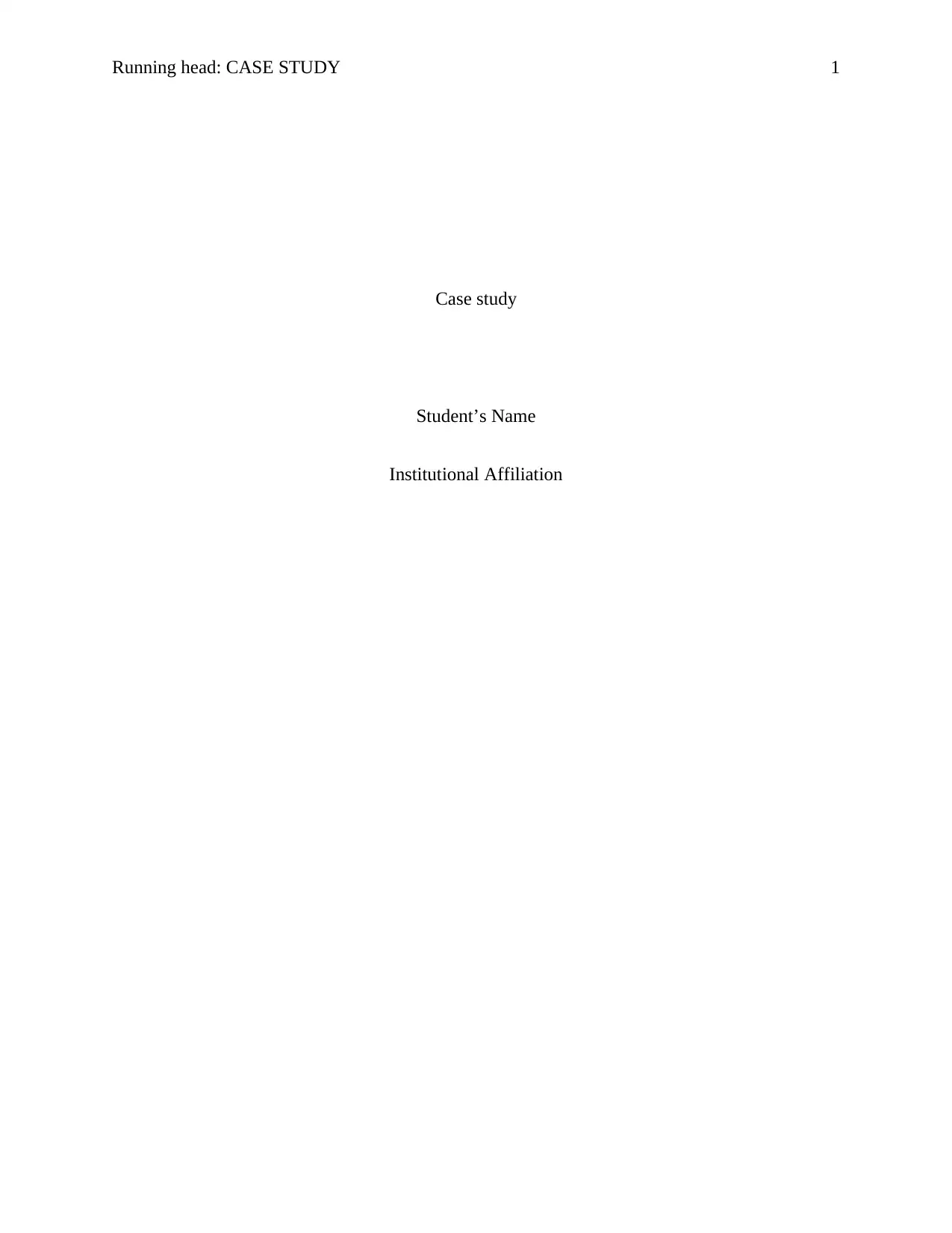
Running head: CASE STUDY 1
Case study
Student’s Name
Institutional Affiliation
Case study
Student’s Name
Institutional Affiliation
Paraphrase This Document
Need a fresh take? Get an instant paraphrase of this document with our AI Paraphraser
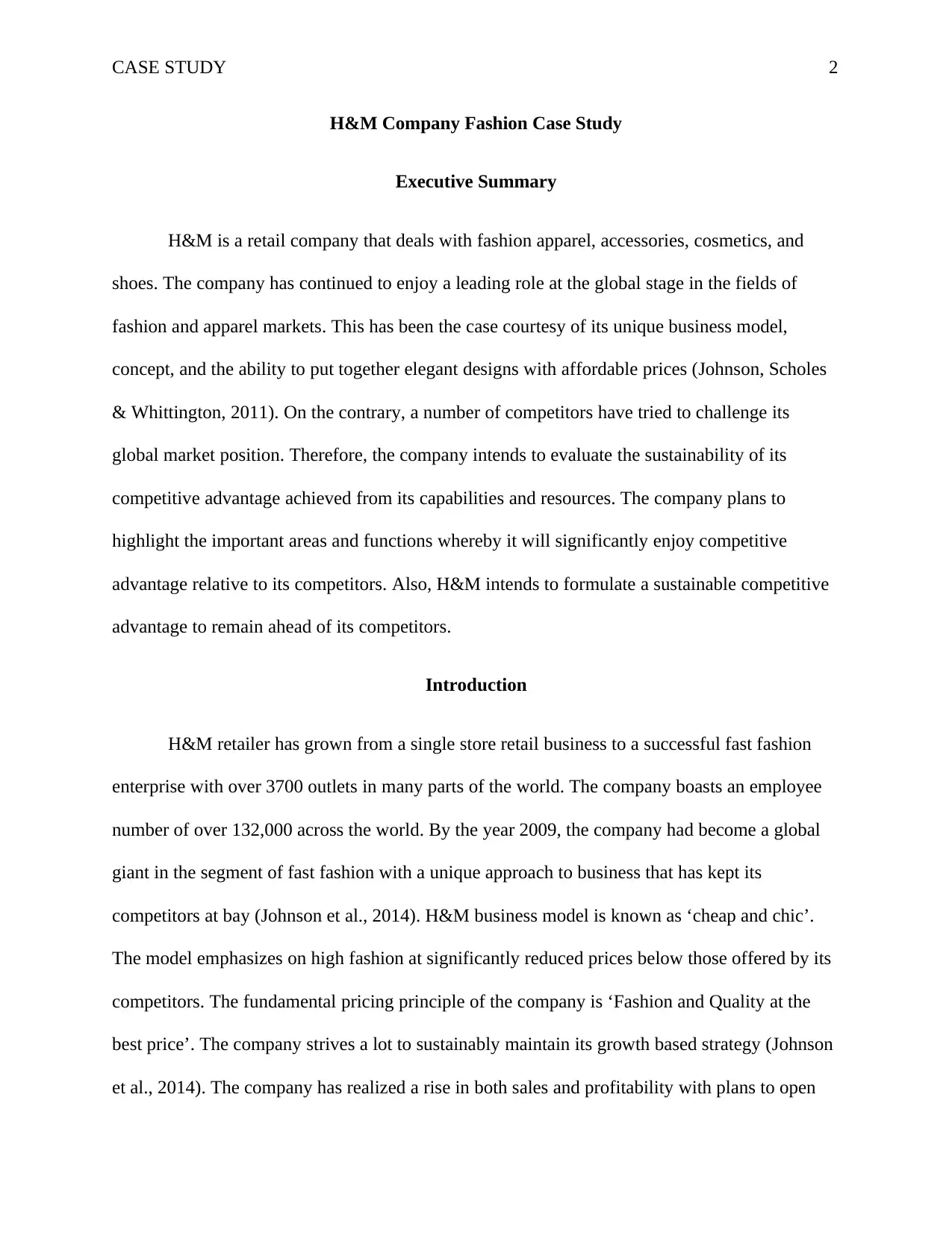
CASE STUDY 2
H&M Company Fashion Case Study
Executive Summary
H&M is a retail company that deals with fashion apparel, accessories, cosmetics, and
shoes. The company has continued to enjoy a leading role at the global stage in the fields of
fashion and apparel markets. This has been the case courtesy of its unique business model,
concept, and the ability to put together elegant designs with affordable prices (Johnson, Scholes
& Whittington, 2011). On the contrary, a number of competitors have tried to challenge its
global market position. Therefore, the company intends to evaluate the sustainability of its
competitive advantage achieved from its capabilities and resources. The company plans to
highlight the important areas and functions whereby it will significantly enjoy competitive
advantage relative to its competitors. Also, H&M intends to formulate a sustainable competitive
advantage to remain ahead of its competitors.
Introduction
H&M retailer has grown from a single store retail business to a successful fast fashion
enterprise with over 3700 outlets in many parts of the world. The company boasts an employee
number of over 132,000 across the world. By the year 2009, the company had become a global
giant in the segment of fast fashion with a unique approach to business that has kept its
competitors at bay (Johnson et al., 2014). H&M business model is known as ‘cheap and chic’.
The model emphasizes on high fashion at significantly reduced prices below those offered by its
competitors. The fundamental pricing principle of the company is ‘Fashion and Quality at the
best price’. The company strives a lot to sustainably maintain its growth based strategy (Johnson
et al., 2014). The company has realized a rise in both sales and profitability with plans to open
H&M Company Fashion Case Study
Executive Summary
H&M is a retail company that deals with fashion apparel, accessories, cosmetics, and
shoes. The company has continued to enjoy a leading role at the global stage in the fields of
fashion and apparel markets. This has been the case courtesy of its unique business model,
concept, and the ability to put together elegant designs with affordable prices (Johnson, Scholes
& Whittington, 2011). On the contrary, a number of competitors have tried to challenge its
global market position. Therefore, the company intends to evaluate the sustainability of its
competitive advantage achieved from its capabilities and resources. The company plans to
highlight the important areas and functions whereby it will significantly enjoy competitive
advantage relative to its competitors. Also, H&M intends to formulate a sustainable competitive
advantage to remain ahead of its competitors.
Introduction
H&M retailer has grown from a single store retail business to a successful fast fashion
enterprise with over 3700 outlets in many parts of the world. The company boasts an employee
number of over 132,000 across the world. By the year 2009, the company had become a global
giant in the segment of fast fashion with a unique approach to business that has kept its
competitors at bay (Johnson et al., 2014). H&M business model is known as ‘cheap and chic’.
The model emphasizes on high fashion at significantly reduced prices below those offered by its
competitors. The fundamental pricing principle of the company is ‘Fashion and Quality at the
best price’. The company strives a lot to sustainably maintain its growth based strategy (Johnson
et al., 2014). The company has realized a rise in both sales and profitability with plans to open
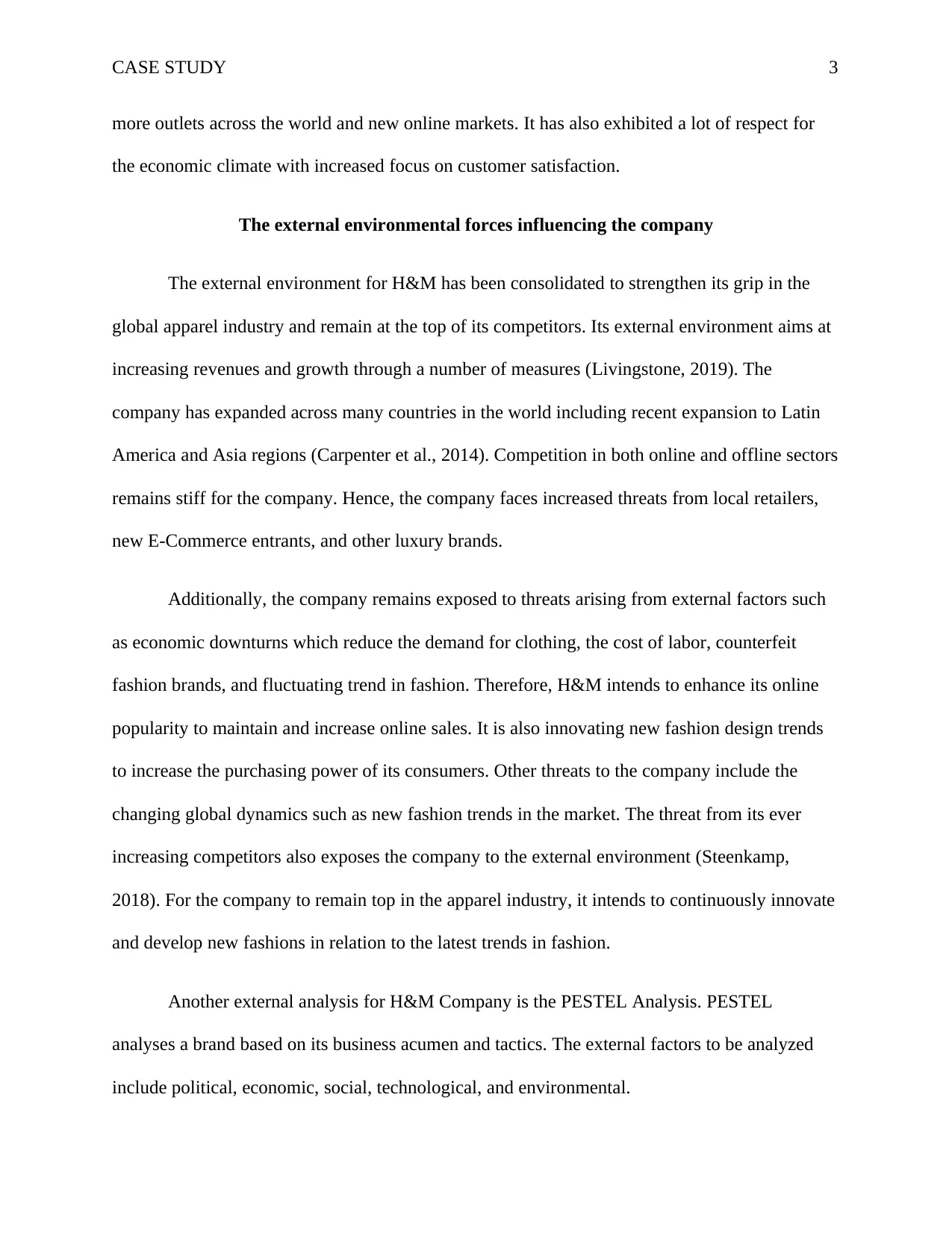
CASE STUDY 3
more outlets across the world and new online markets. It has also exhibited a lot of respect for
the economic climate with increased focus on customer satisfaction.
The external environmental forces influencing the company
The external environment for H&M has been consolidated to strengthen its grip in the
global apparel industry and remain at the top of its competitors. Its external environment aims at
increasing revenues and growth through a number of measures (Livingstone, 2019). The
company has expanded across many countries in the world including recent expansion to Latin
America and Asia regions (Carpenter et al., 2014). Competition in both online and offline sectors
remains stiff for the company. Hence, the company faces increased threats from local retailers,
new E-Commerce entrants, and other luxury brands.
Additionally, the company remains exposed to threats arising from external factors such
as economic downturns which reduce the demand for clothing, the cost of labor, counterfeit
fashion brands, and fluctuating trend in fashion. Therefore, H&M intends to enhance its online
popularity to maintain and increase online sales. It is also innovating new fashion design trends
to increase the purchasing power of its consumers. Other threats to the company include the
changing global dynamics such as new fashion trends in the market. The threat from its ever
increasing competitors also exposes the company to the external environment (Steenkamp,
2018). For the company to remain top in the apparel industry, it intends to continuously innovate
and develop new fashions in relation to the latest trends in fashion.
Another external analysis for H&M Company is the PESTEL Analysis. PESTEL
analyses a brand based on its business acumen and tactics. The external factors to be analyzed
include political, economic, social, technological, and environmental.
more outlets across the world and new online markets. It has also exhibited a lot of respect for
the economic climate with increased focus on customer satisfaction.
The external environmental forces influencing the company
The external environment for H&M has been consolidated to strengthen its grip in the
global apparel industry and remain at the top of its competitors. Its external environment aims at
increasing revenues and growth through a number of measures (Livingstone, 2019). The
company has expanded across many countries in the world including recent expansion to Latin
America and Asia regions (Carpenter et al., 2014). Competition in both online and offline sectors
remains stiff for the company. Hence, the company faces increased threats from local retailers,
new E-Commerce entrants, and other luxury brands.
Additionally, the company remains exposed to threats arising from external factors such
as economic downturns which reduce the demand for clothing, the cost of labor, counterfeit
fashion brands, and fluctuating trend in fashion. Therefore, H&M intends to enhance its online
popularity to maintain and increase online sales. It is also innovating new fashion design trends
to increase the purchasing power of its consumers. Other threats to the company include the
changing global dynamics such as new fashion trends in the market. The threat from its ever
increasing competitors also exposes the company to the external environment (Steenkamp,
2018). For the company to remain top in the apparel industry, it intends to continuously innovate
and develop new fashions in relation to the latest trends in fashion.
Another external analysis for H&M Company is the PESTEL Analysis. PESTEL
analyses a brand based on its business acumen and tactics. The external factors to be analyzed
include political, economic, social, technological, and environmental.
⊘ This is a preview!⊘
Do you want full access?
Subscribe today to unlock all pages.

Trusted by 1+ million students worldwide
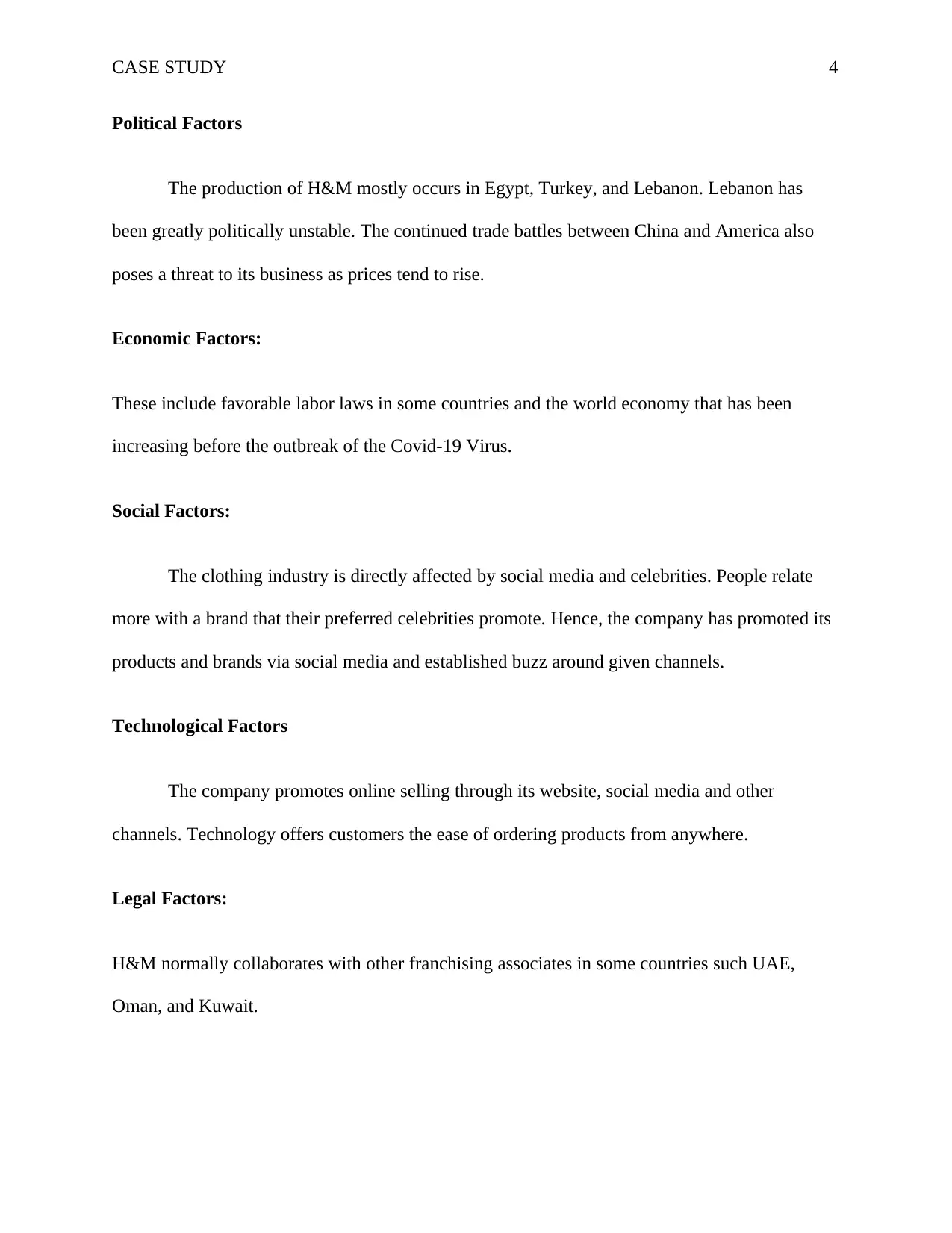
CASE STUDY 4
Political Factors
The production of H&M mostly occurs in Egypt, Turkey, and Lebanon. Lebanon has
been greatly politically unstable. The continued trade battles between China and America also
poses a threat to its business as prices tend to rise.
Economic Factors:
These include favorable labor laws in some countries and the world economy that has been
increasing before the outbreak of the Covid-19 Virus.
Social Factors:
The clothing industry is directly affected by social media and celebrities. People relate
more with a brand that their preferred celebrities promote. Hence, the company has promoted its
products and brands via social media and established buzz around given channels.
Technological Factors
The company promotes online selling through its website, social media and other
channels. Technology offers customers the ease of ordering products from anywhere.
Legal Factors:
H&M normally collaborates with other franchising associates in some countries such UAE,
Oman, and Kuwait.
Political Factors
The production of H&M mostly occurs in Egypt, Turkey, and Lebanon. Lebanon has
been greatly politically unstable. The continued trade battles between China and America also
poses a threat to its business as prices tend to rise.
Economic Factors:
These include favorable labor laws in some countries and the world economy that has been
increasing before the outbreak of the Covid-19 Virus.
Social Factors:
The clothing industry is directly affected by social media and celebrities. People relate
more with a brand that their preferred celebrities promote. Hence, the company has promoted its
products and brands via social media and established buzz around given channels.
Technological Factors
The company promotes online selling through its website, social media and other
channels. Technology offers customers the ease of ordering products from anywhere.
Legal Factors:
H&M normally collaborates with other franchising associates in some countries such UAE,
Oman, and Kuwait.
Paraphrase This Document
Need a fresh take? Get an instant paraphrase of this document with our AI Paraphraser
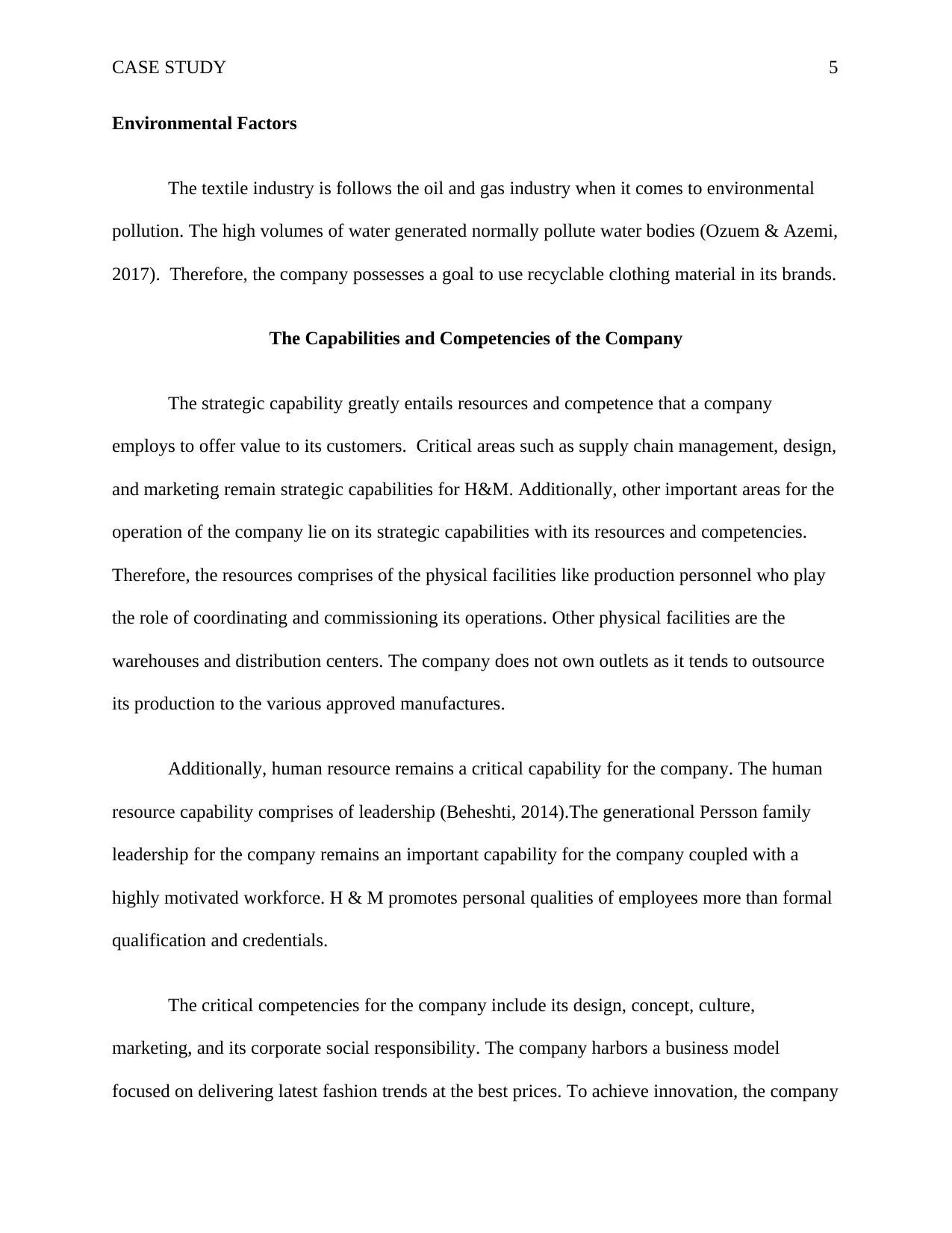
CASE STUDY 5
Environmental Factors
The textile industry is follows the oil and gas industry when it comes to environmental
pollution. The high volumes of water generated normally pollute water bodies (Ozuem & Azemi,
2017). Therefore, the company possesses a goal to use recyclable clothing material in its brands.
The Capabilities and Competencies of the Company
The strategic capability greatly entails resources and competence that a company
employs to offer value to its customers. Critical areas such as supply chain management, design,
and marketing remain strategic capabilities for H&M. Additionally, other important areas for the
operation of the company lie on its strategic capabilities with its resources and competencies.
Therefore, the resources comprises of the physical facilities like production personnel who play
the role of coordinating and commissioning its operations. Other physical facilities are the
warehouses and distribution centers. The company does not own outlets as it tends to outsource
its production to the various approved manufactures.
Additionally, human resource remains a critical capability for the company. The human
resource capability comprises of leadership (Beheshti, 2014).The generational Persson family
leadership for the company remains an important capability for the company coupled with a
highly motivated workforce. H & M promotes personal qualities of employees more than formal
qualification and credentials.
The critical competencies for the company include its design, concept, culture,
marketing, and its corporate social responsibility. The company harbors a business model
focused on delivering latest fashion trends at the best prices. To achieve innovation, the company
Environmental Factors
The textile industry is follows the oil and gas industry when it comes to environmental
pollution. The high volumes of water generated normally pollute water bodies (Ozuem & Azemi,
2017). Therefore, the company possesses a goal to use recyclable clothing material in its brands.
The Capabilities and Competencies of the Company
The strategic capability greatly entails resources and competence that a company
employs to offer value to its customers. Critical areas such as supply chain management, design,
and marketing remain strategic capabilities for H&M. Additionally, other important areas for the
operation of the company lie on its strategic capabilities with its resources and competencies.
Therefore, the resources comprises of the physical facilities like production personnel who play
the role of coordinating and commissioning its operations. Other physical facilities are the
warehouses and distribution centers. The company does not own outlets as it tends to outsource
its production to the various approved manufactures.
Additionally, human resource remains a critical capability for the company. The human
resource capability comprises of leadership (Beheshti, 2014).The generational Persson family
leadership for the company remains an important capability for the company coupled with a
highly motivated workforce. H & M promotes personal qualities of employees more than formal
qualification and credentials.
The critical competencies for the company include its design, concept, culture,
marketing, and its corporate social responsibility. The company harbors a business model
focused on delivering latest fashion trends at the best prices. To achieve innovation, the company
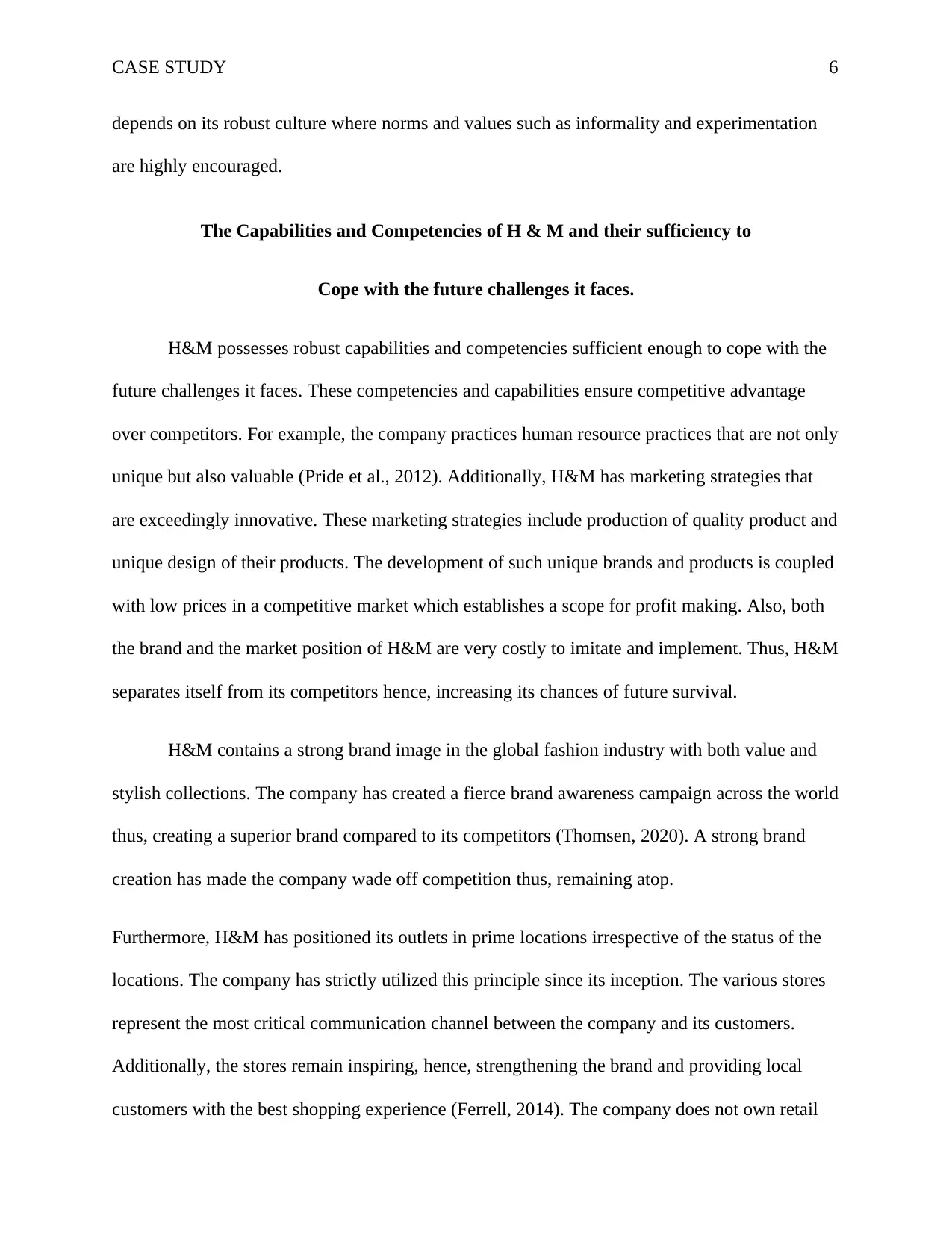
CASE STUDY 6
depends on its robust culture where norms and values such as informality and experimentation
are highly encouraged.
The Capabilities and Competencies of H & M and their sufficiency to
Cope with the future challenges it faces.
H&M possesses robust capabilities and competencies sufficient enough to cope with the
future challenges it faces. These competencies and capabilities ensure competitive advantage
over competitors. For example, the company practices human resource practices that are not only
unique but also valuable (Pride et al., 2012). Additionally, H&M has marketing strategies that
are exceedingly innovative. These marketing strategies include production of quality product and
unique design of their products. The development of such unique brands and products is coupled
with low prices in a competitive market which establishes a scope for profit making. Also, both
the brand and the market position of H&M are very costly to imitate and implement. Thus, H&M
separates itself from its competitors hence, increasing its chances of future survival.
H&M contains a strong brand image in the global fashion industry with both value and
stylish collections. The company has created a fierce brand awareness campaign across the world
thus, creating a superior brand compared to its competitors (Thomsen, 2020). A strong brand
creation has made the company wade off competition thus, remaining atop.
Furthermore, H&M has positioned its outlets in prime locations irrespective of the status of the
locations. The company has strictly utilized this principle since its inception. The various stores
represent the most critical communication channel between the company and its customers.
Additionally, the stores remain inspiring, hence, strengthening the brand and providing local
customers with the best shopping experience (Ferrell, 2014). The company does not own retail
depends on its robust culture where norms and values such as informality and experimentation
are highly encouraged.
The Capabilities and Competencies of H & M and their sufficiency to
Cope with the future challenges it faces.
H&M possesses robust capabilities and competencies sufficient enough to cope with the
future challenges it faces. These competencies and capabilities ensure competitive advantage
over competitors. For example, the company practices human resource practices that are not only
unique but also valuable (Pride et al., 2012). Additionally, H&M has marketing strategies that
are exceedingly innovative. These marketing strategies include production of quality product and
unique design of their products. The development of such unique brands and products is coupled
with low prices in a competitive market which establishes a scope for profit making. Also, both
the brand and the market position of H&M are very costly to imitate and implement. Thus, H&M
separates itself from its competitors hence, increasing its chances of future survival.
H&M contains a strong brand image in the global fashion industry with both value and
stylish collections. The company has created a fierce brand awareness campaign across the world
thus, creating a superior brand compared to its competitors (Thomsen, 2020). A strong brand
creation has made the company wade off competition thus, remaining atop.
Furthermore, H&M has positioned its outlets in prime locations irrespective of the status of the
locations. The company has strictly utilized this principle since its inception. The various stores
represent the most critical communication channel between the company and its customers.
Additionally, the stores remain inspiring, hence, strengthening the brand and providing local
customers with the best shopping experience (Ferrell, 2014). The company does not own retail
⊘ This is a preview!⊘
Do you want full access?
Subscribe today to unlock all pages.

Trusted by 1+ million students worldwide
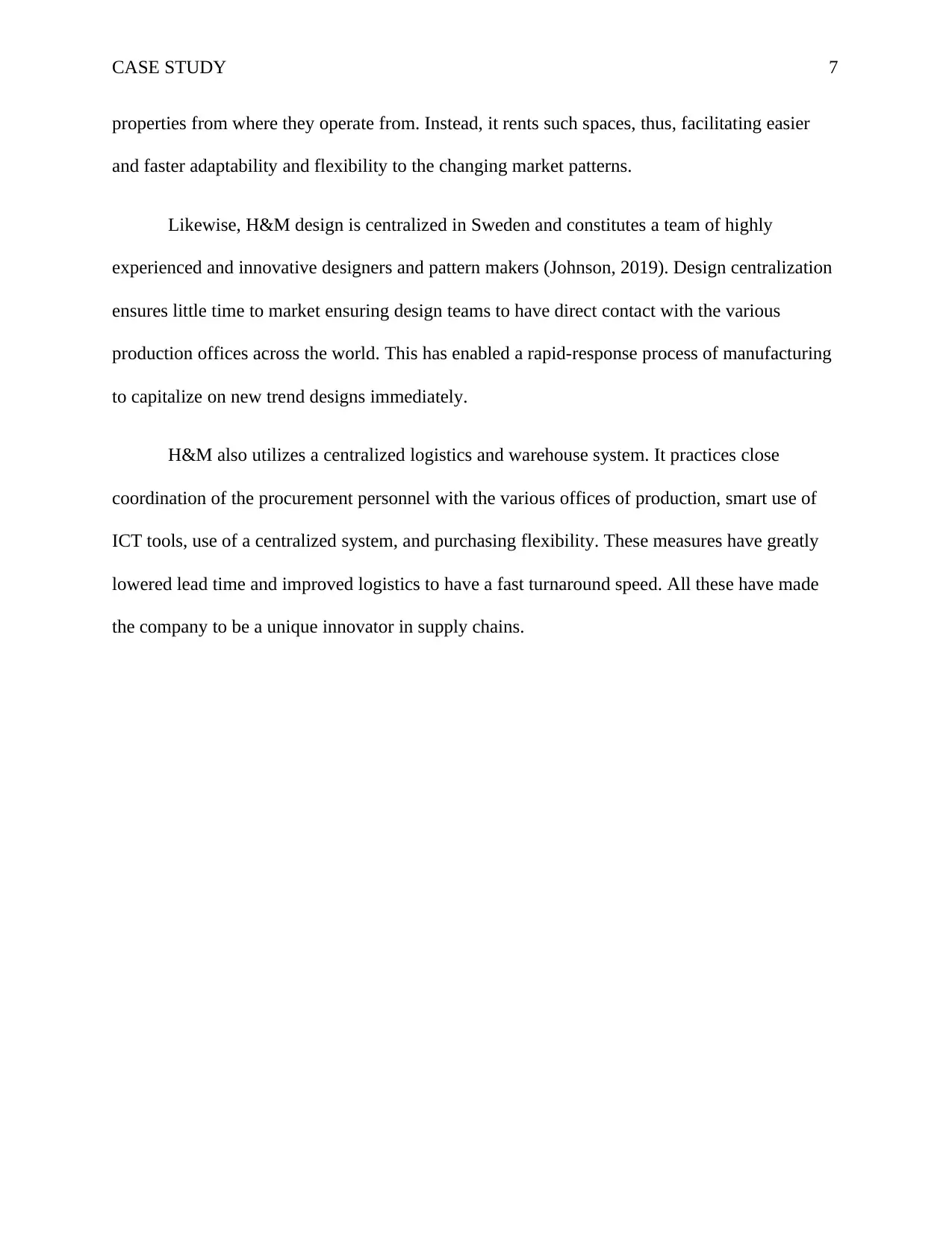
CASE STUDY 7
properties from where they operate from. Instead, it rents such spaces, thus, facilitating easier
and faster adaptability and flexibility to the changing market patterns.
Likewise, H&M design is centralized in Sweden and constitutes a team of highly
experienced and innovative designers and pattern makers (Johnson, 2019). Design centralization
ensures little time to market ensuring design teams to have direct contact with the various
production offices across the world. This has enabled a rapid-response process of manufacturing
to capitalize on new trend designs immediately.
H&M also utilizes a centralized logistics and warehouse system. It practices close
coordination of the procurement personnel with the various offices of production, smart use of
ICT tools, use of a centralized system, and purchasing flexibility. These measures have greatly
lowered lead time and improved logistics to have a fast turnaround speed. All these have made
the company to be a unique innovator in supply chains.
properties from where they operate from. Instead, it rents such spaces, thus, facilitating easier
and faster adaptability and flexibility to the changing market patterns.
Likewise, H&M design is centralized in Sweden and constitutes a team of highly
experienced and innovative designers and pattern makers (Johnson, 2019). Design centralization
ensures little time to market ensuring design teams to have direct contact with the various
production offices across the world. This has enabled a rapid-response process of manufacturing
to capitalize on new trend designs immediately.
H&M also utilizes a centralized logistics and warehouse system. It practices close
coordination of the procurement personnel with the various offices of production, smart use of
ICT tools, use of a centralized system, and purchasing flexibility. These measures have greatly
lowered lead time and improved logistics to have a fast turnaround speed. All these have made
the company to be a unique innovator in supply chains.
Paraphrase This Document
Need a fresh take? Get an instant paraphrase of this document with our AI Paraphraser
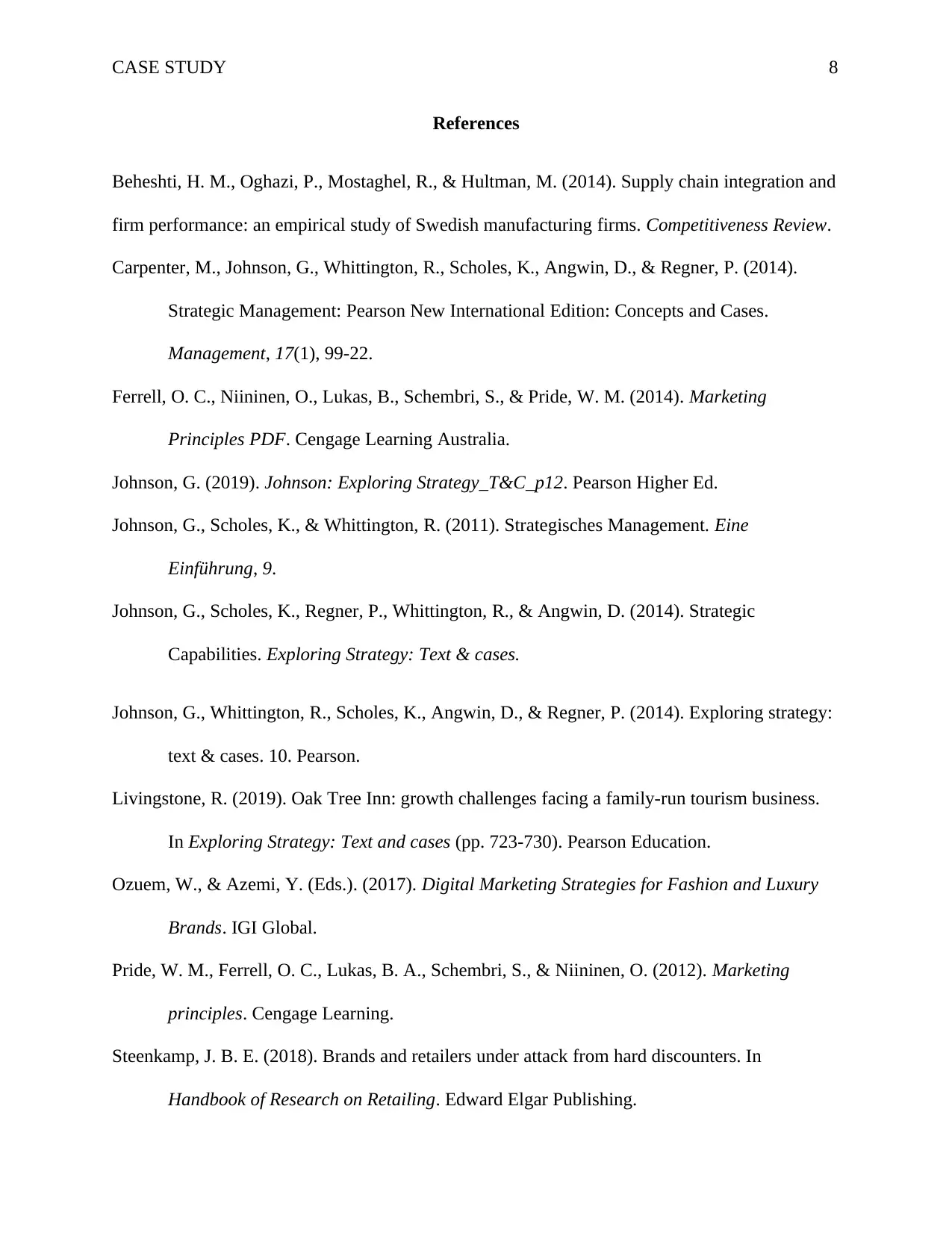
CASE STUDY 8
References
Beheshti, H. M., Oghazi, P., Mostaghel, R., & Hultman, M. (2014). Supply chain integration and
firm performance: an empirical study of Swedish manufacturing firms. Competitiveness Review.
Carpenter, M., Johnson, G., Whittington, R., Scholes, K., Angwin, D., & Regner, P. (2014).
Strategic Management: Pearson New International Edition: Concepts and Cases.
Management, 17(1), 99-22.
Ferrell, O. C., Niininen, O., Lukas, B., Schembri, S., & Pride, W. M. (2014). Marketing
Principles PDF. Cengage Learning Australia.
Johnson, G. (2019). Johnson: Exploring Strategy_T&C_p12. Pearson Higher Ed.
Johnson, G., Scholes, K., & Whittington, R. (2011). Strategisches Management. Eine
Einführung, 9.
Johnson, G., Scholes, K., Regner, P., Whittington, R., & Angwin, D. (2014). Strategic
Capabilities. Exploring Strategy: Text & cases.
Johnson, G., Whittington, R., Scholes, K., Angwin, D., & Regner, P. (2014). Exploring strategy:
text & cases. 10. Pearson.
Livingstone, R. (2019). Oak Tree Inn: growth challenges facing a family-run tourism business.
In Exploring Strategy: Text and cases (pp. 723-730). Pearson Education.
Ozuem, W., & Azemi, Y. (Eds.). (2017). Digital Marketing Strategies for Fashion and Luxury
Brands. IGI Global.
Pride, W. M., Ferrell, O. C., Lukas, B. A., Schembri, S., & Niininen, O. (2012). Marketing
principles. Cengage Learning.
Steenkamp, J. B. E. (2018). Brands and retailers under attack from hard discounters. In
Handbook of Research on Retailing. Edward Elgar Publishing.
References
Beheshti, H. M., Oghazi, P., Mostaghel, R., & Hultman, M. (2014). Supply chain integration and
firm performance: an empirical study of Swedish manufacturing firms. Competitiveness Review.
Carpenter, M., Johnson, G., Whittington, R., Scholes, K., Angwin, D., & Regner, P. (2014).
Strategic Management: Pearson New International Edition: Concepts and Cases.
Management, 17(1), 99-22.
Ferrell, O. C., Niininen, O., Lukas, B., Schembri, S., & Pride, W. M. (2014). Marketing
Principles PDF. Cengage Learning Australia.
Johnson, G. (2019). Johnson: Exploring Strategy_T&C_p12. Pearson Higher Ed.
Johnson, G., Scholes, K., & Whittington, R. (2011). Strategisches Management. Eine
Einführung, 9.
Johnson, G., Scholes, K., Regner, P., Whittington, R., & Angwin, D. (2014). Strategic
Capabilities. Exploring Strategy: Text & cases.
Johnson, G., Whittington, R., Scholes, K., Angwin, D., & Regner, P. (2014). Exploring strategy:
text & cases. 10. Pearson.
Livingstone, R. (2019). Oak Tree Inn: growth challenges facing a family-run tourism business.
In Exploring Strategy: Text and cases (pp. 723-730). Pearson Education.
Ozuem, W., & Azemi, Y. (Eds.). (2017). Digital Marketing Strategies for Fashion and Luxury
Brands. IGI Global.
Pride, W. M., Ferrell, O. C., Lukas, B. A., Schembri, S., & Niininen, O. (2012). Marketing
principles. Cengage Learning.
Steenkamp, J. B. E. (2018). Brands and retailers under attack from hard discounters. In
Handbook of Research on Retailing. Edward Elgar Publishing.

CASE STUDY 9
Thomsen, J. (2020). Organisation and Management. Pearson Higher Ed.
Thomsen, J. (2020). Organisation and Management. Pearson Higher Ed.
⊘ This is a preview!⊘
Do you want full access?
Subscribe today to unlock all pages.

Trusted by 1+ million students worldwide
1 out of 9
Related Documents
Your All-in-One AI-Powered Toolkit for Academic Success.
+13062052269
info@desklib.com
Available 24*7 on WhatsApp / Email
![[object Object]](/_next/static/media/star-bottom.7253800d.svg)
Unlock your academic potential
Copyright © 2020–2025 A2Z Services. All Rights Reserved. Developed and managed by ZUCOL.





